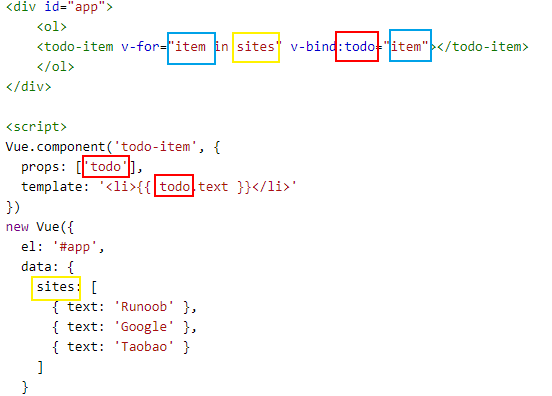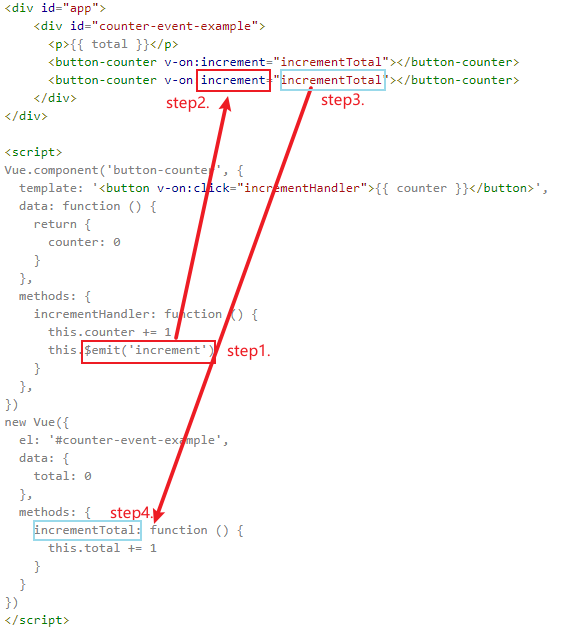vue.js组件
Prop
prop 是子组件用来接受父组件传递过来的数据的一个自定义属性。
父组件的数据需要通过 props 把数据传给子组件,子组件需要显式地用 props 选项声明 “prop”:
1
2
3
4
5
6
7
8
9
10
11
12
13
14
15
16
17
18
19
20
21
22
23
24
25
26
27
| <!DOCTYPE html>
<html>
<head>
<meta charset="utf-8">
<title>Vue 测试实例 - 菜鸟教程(runoob.com)</title>
<script src="https://cdn.staticfile.org/vue/2.2.2/vue.min.js"></script>
</head>
<body>
<div id="app">
<child message="hello!"></child>
</div>
<script>
// 注册
Vue.component('child', {
// 声明 props
props: ['message'],
// 同样也可以在 vm 实例中像 “this.message” 这样使用
template: '<span>{{ message }}</span>'
})
// 创建根实例
new Vue({
el: '#app'
})
</script>
</body>
</html>
|
动态 Prop
1
2
3
4
5
6
7
8
9
10
11
12
13
14
15
16
17
18
19
20
21
22
23
24
25
26
27
28
29
30
31
32
33
34
| <!DOCTYPE html>
<html>
<head>
<meta charset="utf-8">
<title>Vue 测试实例 - 菜鸟教程(runoob.com)</title>
<script src="https://cdn.staticfile.org/vue/2.2.2/vue.min.js"></script>
</head>
<body>
<div id="app">
<div>
<input v-model="parentMsg">
<br>
<child v-bind:message="parentMsg"></child>
</div>
</div>
<script>
// 注册
Vue.component('child', {
// 声明 props
props: ['message'],
// 同样也可以在 vm 实例中像 “this.message” 这样使用
template: '<span>{{ message }}</span>'
})
// 创建根实例
new Vue({
el: '#app',
data: {
parentMsg: '父组件内容'
}
})
</script>
</body>
</html>
|

1
2
3
4
5
6
7
8
9
10
11
12
13
14
15
16
17
18
19
20
21
22
23
24
25
26
27
28
29
30
31
32
| <!DOCTYPE html>
<html>
<head>
<meta charset="utf-8">
<title>Vue 测试实例 - 菜鸟教程(runoob.com)</title>
<script src="https://cdn.staticfile.org/vue/2.2.2/vue.min.js"></script>
</head>
<body>
<div id="app">
<ol>
<todo-item v-for="item in sites" v-bind:todo="item"></todo-item>
</ol>
</div>
<script>
Vue.component('todo-item', {
props: ['todo'],
template: '<li>{{ todo.text }}</li>'
})
new Vue({
el: '#app',
data: {
sites: [
{ text: 'Runoob' },
{ text: 'Google' },
{ text: 'Taobao' }
]
}
})
</script>
</body>
</html>
|

注意: prop 是单向绑定的:当父组件的属性变化时,将传导给子组件,但是不会反过来。
Prop 验证
1
2
3
4
5
6
7
8
9
10
11
12
13
14
15
16
17
18
19
20
21
22
23
24
25
26
27
28
29
30
31
32
33
| Vue.component('my-component', {
props: {
propA: Number,
propB: [String, Number],
propC: {
type: String,
required: true
},
propD: {
type: Number,
default: 100
},
propE: {
type: Object,
default: function () {
return { message: 'hello' }
}
},
propF: {
validator: function (value) {
return ['success', 'warning', 'danger'].indexOf(value) !== -1
}
}
}
})
|
自定义事件
父组件是使用 props 传递数据给子组件,但如果子组件要把数据传递回去,就需要使用自定义事件!
我们可以使用 v-on 绑定自定义事件, 每个 Vue 实例都实现了事件接口(Events interface),即:
- 使用
$on(eventName) 监听事件
- 使用
$emit(eventName) 触发事件
另外,父组件可以在使用子组件的地方直接用 v-on 来监听子组件触发的事件。
以下实例中子组件已经和它外部完全解耦了。它所做的只是触发一个父组件关心的内部事件
1
2
3
4
5
6
7
8
9
10
11
12
13
14
15
16
17
18
19
20
21
22
23
24
25
26
27
28
29
30
31
32
33
34
35
36
37
38
39
40
41
42
43
44
45
| <!DOCTYPE html>
<html>
<head>
<meta charset="utf-8">
<title>Vue 测试实例 - 菜鸟教程(runoob.com)</title>
<script src="https://cdn.staticfile.org/vue/2.2.2/vue.min.js"></script>
</head>
<body>
<div id="app">
<div id="counter-event-example">
<p>{{ total }}</p>
<button-counter v-on:increment="incrementTotal"></button-counter>
<button-counter v-on:increment="incrementTotal"></button-counter>
</div>
</div>
<script>
Vue.component('button-counter', {
template: '<button v-on:click="incrementHandler">{{ counter }}</button>',
data: function () {
return {
counter: 0
}
},
methods: {
incrementHandler: function () {
this.counter += 1
this.$emit('increment')
}
},
})
new Vue({
el: '#counter-event-example',
data: {
total: 0
},
methods: {
incrementTotal: function () {
this.total += 1
}
}
})
</script>
</body>
</html>
|

data 必须是一个函数
上面例子中,可以看到 button-counter 组件中的 data 不是一个对象,而是一个函数:
1
2
3
4
5
| data: function () {
return {
count: 0
}
}
|
这样的好处就是每个实例可以维护一份被返回对象的独立的拷贝
如果 data 是一个对象则会影响到其他实例,如下所示:
1
2
3
4
5
6
7
8
9
10
11
12
13
14
15
16
17
18
19
20
21
22
23
24
25
26
27
28
29
30
31
32
33
34
35
36
37
| <!DOCTYPE html>
<html>
<head>
<meta charset="utf-8">
<title>Vue 测试实例 - 菜鸟教程(runoob.com)</title>
<script src="https://cdn.staticfile.org/vue/2.2.2/vue.min.js"></script>
</head>
<body>
<div id="components-demo3" class="demo">
<button-counter2></button-counter2>
<button-counter2></button-counter2>
<button-counter2></button-counter2>
</div>
<script>
var buttonCounter2Data = {
count: 0
}
Vue.component('button-counter2', {
/*
data: function () {
// data 选项是一个函数,组件不相互影响
return {
count: 0
}
},
*/
data: function () {
// data 选项是一个对象,会影响到其他实例
return buttonCounter2Data
},
template: '<button v-on:click="count++">点击了 {{ count }} 次。</button>'
})
new Vue({ el: '#components-demo3' })
</script>
</body>
</html>
|
自定义组件的 v-model
组件上的 v-model 默认会利用名为 value 的 prop 和名为 input 的事件
1
| <input v-model="parentData">
|
等价于:
1
2
3
4
| <input
:value="parentData"
@input="parentData = $event.target.value"
>
|
以下实例自定义组件 runoob-input,父组件的 num 的初始值是 100
更改子组件的值能实时更新父组件的 num:
1
2
3
4
5
6
7
8
9
10
11
12
13
14
15
16
17
18
19
20
21
22
23
24
25
26
27
28
29
30
31
32
33
34
35
| <!DOCTYPE html>
<html>
<head>
<meta charset="utf-8">
<title>Vue 测试实例 - 菜鸟教程(runoob.com)</title>
<script src="https://cdn.staticfile.org/vue/2.2.2/vue.min.js"></script>
</head>
<body>
<div id="app">
<runoob-input v-model="num"></runoob-input>
<p>输入的数字为:{{num}}</p>
</div>
<script>
Vue.component('runoob-input', {
template: `
<p> <!-- 包含了名为 input 的事件 -->
<input
ref="input"
:value="value"
@input="$emit('input', $event.target.value)"
>
</p>
`,
props: ['value'], // 名为 value 的 prop
})
new Vue({
el: '#app',
data: {
num: 100,
}
})
</script>
</body>
</html>
|
由于 v-model 默认传的是 value,不是 checked,所以对于对于复选框或者单选框的组件时,我们需要使用 model 选项,model 选项可以指定当前的事件类型和传入的 props。
1
2
3
4
5
6
7
8
9
10
11
12
13
14
15
16
17
18
19
20
21
22
23
24
25
26
27
28
29
30
31
32
33
34
35
36
37
38
39
40
41
42
43
44
| <!DOCTYPE html>
<html>
<head>
<meta charset="utf-8">
<title>Vue 测试实例 - 菜鸟教程(runoob.com)</title>
<script src="https://cdn.staticfile.org/vue/2.2.2/vue.min.js"></script>
</head>
<body>
<div id="app">
<base-checkbox v-model="lovingVue"></base-checkbox>
<div v-show="lovingVue">
如果选择框打勾我就会显示。
</div>
</div>
<script>
// 注册
Vue.component('base-checkbox', {
model: {
prop: 'checked',
event: 'change' // onchange 事件
},
props: {
checked: Boolean
},
template: `
<input
type="checkbox"
v-bind:checked="checked"
v-on:change="$emit('change', $event.target.checked)"
>
`
})
// 创建根实例
new Vue({
el: '#app',
data: {
lovingVue: true
}
})
</script>
</body>
</html>
|
实例中 lovingVue 的值会传给 checked 的 prop,同时当 触发 change 事件时, lovingVue 的值也会更新。
Vue.js 自定义指令
除了默认设置的核心指令( v-model 和 v-show ), Vue 也允许注册自定义指令。
下面我们注册一个全局指令 v-focus, 该指令的功能是在页面加载时,元素获得焦点:
1
2
3
4
5
6
7
8
9
10
11
12
13
14
15
16
17
18
19
20
21
22
23
24
25
26
27
28
29
| <!DOCTYPE html>
<html>
<head>
<meta charset="utf-8">
<title>Vue 测试实例 - 菜鸟教程(runoob.com)</title>
<script src="https://cdn.staticfile.org/vue/2.2.2/vue.min.js"></script>
</head>
<body>
<div id="app">
<p>页面载入时,input 元素自动获取焦点:</p>
<input v-focus>
</div>
<script>
// 注册一个全局自定义指令 v-focus
Vue.directive('focus', {
// 当绑定元素插入到 DOM 中。
inserted: function (el) {
// 聚焦元素
el.focus()
}
})
// 创建根实例
new Vue({
el: '#app'
})
</script>
</body>
</html>
|
我们也可以在实例使用 directives 选项来注册局部指令,这样指令只能在这个实例中使用:
1
2
3
4
5
6
7
8
9
10
11
12
13
14
15
16
17
18
19
20
21
22
23
24
25
26
27
28
29
30
31
| <!DOCTYPE html>
<html>
<head>
<meta charset="utf-8">
<title>Vue 测试实例 - 菜鸟教程(runoob.com)</title>
<script src="https://cdn.staticfile.org/vue/2.2.2/vue.min.js"></script>
</head>
<body>
<div id="app">
<p>页面载入时,input 元素自动获取焦点:</p>
<input v-focus>
</div>
<script>
// 创建根实例
new Vue({
el: '#app',
directives: {
// 注册一个局部的自定义指令 v-focus
focus: {
// 指令的定义
inserted: function (el) {
// 聚焦元素
el.focus()
}
}
}
})
</script>
</body>
</html>
|
钩子
钩子函数
指令定义函数提供了几个钩子函数(可选):
bind: 只调用一次,指令第一次绑定到元素时调用,用这个钩子函数可以定义一个在绑定时执行一次的初始化动作。inserted: 被绑定元素插入父节点时调用(父节点存在即可调用,不必存在于 document 中)。update: 被绑定元素所在的模板更新时调用,而不论绑定值是否变化。通过比较更新前后的绑定值,可以忽略不必要的模板更新(详细的钩子函数参数见下)。componentUpdated: 被绑定元素所在模板完成一次更新周期时调用。unbind: 只调用一次, 指令与元素解绑时调用。
钩子函数参数
钩子函数的参数有:
el: 指令所绑定的元素,可以用来直接操作 DOM 。
binding: 一个对象,包含以下属性:
value: 指令的绑定值, 例如: v-my-directive="1 + 1", value 的值是 2。
- oldValue: 指令绑定的前一个值,仅在
update 和 componentUpdated 钩子中可用。无论值是否改变都可用。
- expression: 绑定值的表达式或变量名。 例如
v-my-directive="1 + 1" , expression 的值是 "1 + 1"。
- arg: 传给指令的参数。例如
v-my-directive:foo, arg 的值是 "foo"。
- modifiers: 一个包含修饰符的对象。 例如:
v-my-directive.foo.bar, 修饰符对象 modifiers 的值是 { foo: true, bar: true }。
vnode: Vue 编译生成的虚拟节点。
oldVnode: 上一个虚拟节点,仅在 update 和 componentUpdated 钩子中可用。
以下实例演示了这些参数的使用:
1
2
3
4
5
6
7
8
9
10
11
12
13
14
15
16
17
18
19
20
21
22
23
24
25
26
27
28
29
30
31
32
33
| <!DOCTYPE html>
<html>
<head>
<meta charset="utf-8">
<title>Vue 测试实例 - 菜鸟教程(runoob.com)</title>
<script src="https://cdn.staticfile.org/vue/2.2.2/vue.min.js"></script>
</head>
<body>
<div id="app" v-runoob:hello.a.b="message">
</div>
<script>
Vue.directive('runoob', {
bind: function (el, binding, vnode) {
var s = JSON.stringify
el.innerHTML =
'name: ' + s(binding.name) + '<br>' +
'value: ' + s(binding.value) + '<br>' +
'expression: ' + s(binding.expression) + '<br>' +
'argument: ' + s(binding.arg) + '<br>' +
'modifiers: ' + s(binding.modifiers) + '<br>' +
'vnode keys: ' + Object.keys(vnode).join(', ')
}
})
new Vue({
el: '#app',
data: {
message: '菜鸟教程!'
}
})
</script>
</body>
</html>
|
有时候我们不需要其他钩子函数,我们可以简写函数,如下格式:
1
2
3
4
| Vue.directive('runoob', function (el, binding) {
el.style.backgroundColor = binding.value.color
})
|
指令函数可接受所有合法的 JavaScript 表达式,以下实例传入了 JavaScript 对象:
1
2
3
4
5
6
7
8
9
10
11
12
13
14
15
16
17
18
19
20
21
22
23
24
| <!DOCTYPE html>
<html>
<head>
<meta charset="utf-8">
<title>Vue 测试实例 - 菜鸟教程(runoob.com)</title>
<script src="https://cdn.staticfile.org/vue/2.2.2/vue.min.js"></script>
</head>
<body>
<div id="app">
<div v-runoob="{ color: 'green', text: '菜鸟教程!' }"></div>
</div>
<script>
Vue.directive('runoob', function (el, binding) {
// 简写方式设置文本及背景颜色
el.innerHTML = binding.value.text
el.style.backgroundColor = binding.value.color
})
new Vue({
el: '#app'
})
</script>
</body>
</html>
|
问题
v-model的原理

1
2
3
| <!--<input type="text" v-model="message">-->
<!--<input type="text" :value="message" @input="valueChange">-->
<input type="text" :value="message" @input="message = $event.target.value">
|
在用脚手架搭建vue项目时系统禁止运行脚本
- 管理员身份打开
windows PowerShell(A)
- 输入set-ExecutionPolicy RemoteSigned
- 选择Y 或者A ,就好了
vue3.0 取消eslint校验
1
2
3
4
5
| "eslintConfig": {
"root": false,
"env": {
"node": false
},
|
vue.js not detected解决方法
C:\Users\Derek\AppData\Local\Google\Chrome\UserData\Default\Extensions\nhdogjmejiglipccpnnnanhbledajbpd\5.3.3_0 =>找到文件:manifest.json =>将这个修改 “persistent”: true,



